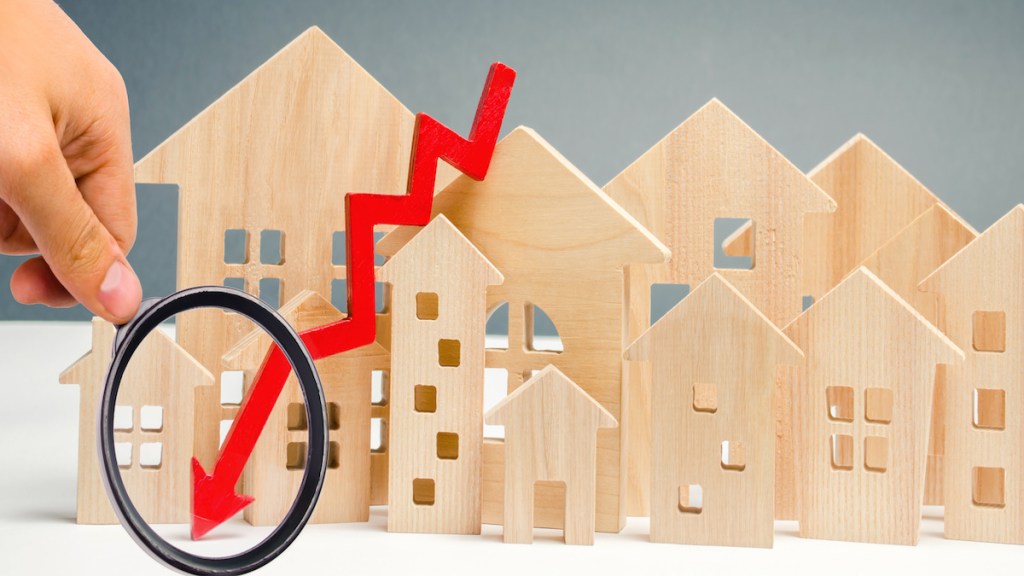
Reports released this week by several respected market observers point to less good and increased bad and ugly ahead for the housing market.
For some of the good, a U.S. Census Bureau report released late last week spurred a bout of optimism when it revealed that new-home sales jumped by nearly 11% month-over-month in May on a seasonally adjusted basis, after declining by 12% in April.
Moody’s Investors Service, in a housing-market report released this week, puts some ugly back into the home-sales figures for May, however.
“At 696,000 units, May new home sales were around 17% below the recent peak of 839,000 units in December last year,” the Moody’s report notes. “[On June 21], the National Association of Realtors said that existing-home sales declined for the fourth consecutive month.
“Existing-home sales fell in May by 3.4% on a seasonally adjusted basis to 5.41 million, the lowest since June of 2020 and similar to pre-pandemic levels.”
Those figures, along with “sharp recent increases in mortgage rates” and other supporting data, lead Moody’s to conclude that the “U.S. home-price boom is over.” The firm, which rates securitization offerings and provides other capital-market services, predicts “material declines” in both new- and existing-home transactions this year, compared with 2021.
Supporting the ugly outlook for the housing market is the release today, June 29, of the quarterly CFO Survey, conducted jointly by Duke University’s Fuqua School of Business and the Federal Reserve Banks of Richmond and Atlanta. The survey of more than 300 U.S. financial executives conducted between May 25 and June 10, shows optimism about the broader U.S. economy continuing to decline.
The average index score for the current survey was 50.7, compared with 54.8 in the prior quarter and 60.3 two quarters ago.
“Price pressures have increased, real revenue growth has stalled and optimism about the overall economy has fallen sharply,” said John Graham, a Fuqua finance professor and the survey’s academic director. “Monetary tightening [by the Federal Reserve] is one of several factors dampening the economic outlook.”
The CFO Survey’s findings are echoed by a revised first-quarter 2022 gross domestic product (GDP) estimate released Wednesday by the U.S. Department of Commerce’s Bureau of Economic Analysis (BEA). It shows that a drastic economic slowdown is already underway.
“Real gross domestic product [a measure of all goods and services produced in the economy] decreased at an annual rate of 1.6 percent in the first quarter of 2022 …,” the BEA report states. “In the fourth quarter of 2021, real GDP increased 6.9 percent.”
The BEA’s first-quarter GDP estimate, it’s third to date, was revised downward from -1.4% and -1.5% in the two prior estimates. The grim data led Mortgage Capital Trading (MCT), a San Diego-based capital market software and services firm, to broach the “R“ word in its daily market-overview report.
“Concern over a slowing economy and aggressive interest rate hikes from the Fed are beginning to dominate market sentiment,” the MCT report states. “This morning’s GDP release [on June 29] came with a downward revision for the last reading, further supporting views that a recession is either in progress or coming soon.”
What does all this mean for the housing market in the months ahead? The Moody’s report attempts to frame some of the expectations.
“We expect some increases in existing-house prices over the next 18 months, though for appreciation to be well below the general rate of inflation,” the Moody’s report states. “After that, we expect home appreciation to settle in at levels somewhat lower than the rate of overall U.S. inflation.”
The report even indicates that there “is risk that existing home prices will have a minor correction over the next two years, similar to housing markets in many other developed counties facing risks after recent booms.”
The “moderation” in the U.S. housing market is ongoing and the full effects of recent rate increases have yet to be fully realized, the Moody’s report adds, especially with respect to housing prices.
Moody’s predicts that housing demand will “dampen significantly” in the months ahead due to the doubling of rates for 30-year fixed mortgages since the start of the year, which is fueling a huge jump in monthly mortgage costs. Freddie Mac’s most recent Primary Mortgage Market Survey shows the average 30-year fixed rate mortgage at 5.81% as of June 23.
“The monthly costs of new mortgages on existing homes sold at median transaction prices [are] more than 60% higher than a year ago,” the Moody’s report states. “Although higher mortgage rates do not always drive home prices lower, they typically affect sales activity and drive down the rate of price appreciation.
“We also expect higher rates to restrict for-sale supply because current homeowners will be reluctant to lose low-rate fixed borrowing costs.”
So, in effect, moderating or even declining home prices could be neutralized by rising borrowing costs, leading the housing market toward stagnation — the doldrums — in the worst-case scenario.
There is some good news mixed in with all this bad and ugly, however. Moody’s points out that some “fundamental housing strengths” will likely help to mitigate the degree of any market correction, at least over the next 12 to 18 months.
Those strengths include “favorable demographic trends, solid underwriting of outstanding mortgages and lingering housing supply constraints from a period of underbuilding,” according to the Moody’s report. Also on the bright side, according to Moody’s, is that a moderate decline in housing prices could be good for the market longer-term. That’s assuming the Federal Reserve wins the fight to tame inflation, now running at 8.6%, without causing a major spike in unemployment, which was at 3.6% in May for the third month in a row, according to the Bureau of Labor Statistics.
In short, the housing market has reached a fork in the road, based on the Moody’s analysis — with one path leading to the doldrums, or even decline, and the other toward resurgence and a new normal.
“If U.S. home prices were to decline modestly, it would increase affordability for potential homebuyers and improve demand, including for individuals who were priced out of the market in the recent months because of rapidly rising interest rates,” Moody’s reasons in its report. “However, sustained large increases in mortgage rates or a material weakening in the labor market could lead to sharper declines in housing activity and prices.”



